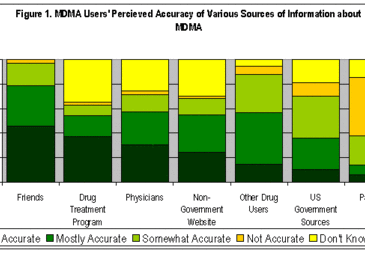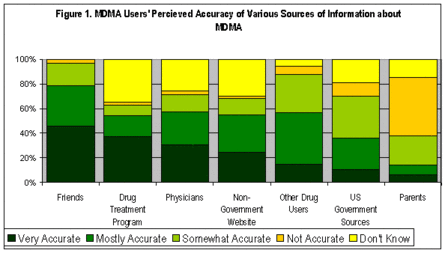The Internet is a plentiful source of information about illicit drugs. In the last issue of STASH (3(3)), we reported a study which examined Internet sites offering to sell non-prescription opioids. The Internet also can be a source of information about illicit drugs. This week’s STASH reviews a study of Methylenedioxymethamphetamine (MDMA, i.e., ecstasy) users’ perceptions about the accuracy of available sources of educational MDMA information. Investigating information that might influence a decision to take an illicit drug can shed light on how best to create effective public health interventions to prevent and minimize harms associated with such drug use.
Falck, Carlson, Wang, and Siegal (2004) employed a snowball sampling method to generate the study sample. To be eligible for the study, participants were 18 to 30 years of age, not currently enrolled in drug treatment, and had used MDMA at least once during the past six months. Identified eligible participants then named acquaintances who were added to the pool of potential participants. Research assistants conducted person-to-person structured interviews asking participants about their sociodemographic characteristics and their perceived accuracy of six main sources of information about MDMA (i.e., US government sources, drug abuse treatment programs, physicians, parents, friends, and other drug users). The authors used descriptive statistics to rank order the sources of information according to accuracy; they used analysis of variance (ANOVA) to test the relationships between participants’ characteristics and Internet use.
Figure. Adapted from Falck et al., 2004. Click image to enlarge.
The sample of 304 participants was predominantly white (81.6%), with a mean age of 21.2 (SD=2.8) years, and 50.3% had at least some college education. Half of the sample reported using the Internet as an informational resource to learn about MDMA. Younger and more educated people tended to seek information using the Internet more than older (F2302=5.47, P=0.005) or less educated (F2302=3.13 P=0.004) participants. Of those participants using the Internet, more than four times as many participants used non-government websites (e.g., http://erowid. com/, http://dancesafe.org/) compared to government websites (e.g., www.NIDA.gov, 28% verses 6.6%). As shown in Figure 1, participants rated friends (45.7%) and Drug Treatment Programs (37%) as very accurate sources of information about MDMA and rated government related resources (10.2%) and parents (5.9%) as the least accurate sources of information about MDMA.
This study has several limitations. First, the authors’ main focus was sources of information about MDMA rather than specifically the nature of information for which the subjects were looking. For example, someone could have been looking for information about the drug experience, others about possible risks. Second, snowball sampling creates a potentially biased sample because people are more likely to invite acquaintances with similar demographic characteristics. Therefore, the study findings might not generalize to all MDMA users. Third, study participants might not report using resources that create cognitive dissonance with their current drug use patterns such as parents and government sources.
The study found that the resource MDMA users perceived as most accurate (i.e., friends) is the source least likely to provide complete or accurate information about MDMA. Friends might be a resource for descriptions of MDMA experiences (e.g., where to get MDMA), but not for reporting adverse cognitive consequences. The sources considered as the next most accurate (i.e. drug treatment programs and physicians) inform users as to the adverse consequences of MDMA. This information derives from experience treating people who use MDMA. Because government sources do not claim to have direct experience treating users, and certainly not experience using MDMA, those seeking information might not trust the accuracy of this source. These findings suggest that effective public health efforts to minimize or prevent harms associated with MDMA should include some information based on the personal experiences of those treating users or taking the drug. More research will be necessary to clarify the efficacy of this strategy.
What do you think? Please use the comment link below to provide feedback on this article.
References
Falck, R. S., Carlson, R. G., Wang, J., & Siegal, H. A. (2004). Sources of information about MDMA (3,4methylenedioxymethamphetamine): perceived accuracy, importance, and implications for prevention among young adult users. Drug and Alcohol Dependence, 74, 45-54.





